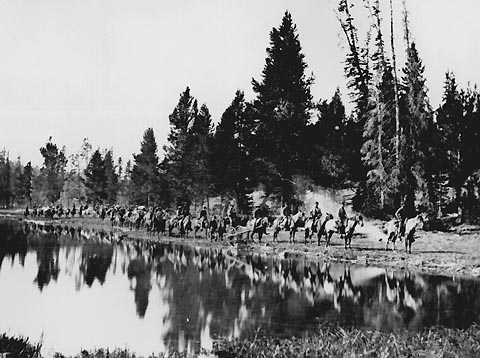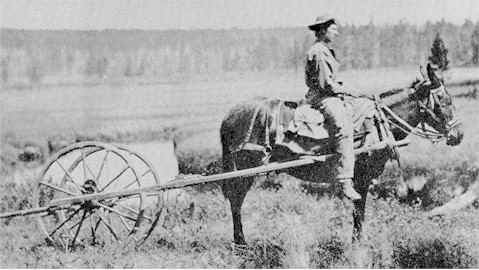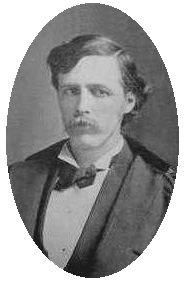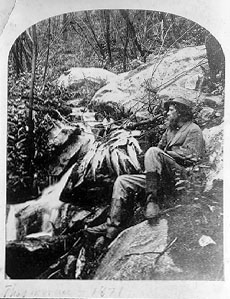
Hayden Expedition between Yellowstone and East Fork Rivers, 1871
Note odometer, cart like device, used by mappers
to estimate distances traveled. See another view of odometer to lower left. Ferdinand Hayden, director of the U.S. Geological Survey,
led an expedition to Yellowstone at the urgings of Nathaniel P Langford, who had participated in the 1870
expedition into Yellowstone led by Henry Washburn (1832-1871), Surveyor General of Montana
Territory. The Washburn Expedition was partially subsidized by Jay Cooke's Northern
Pacific Railroad which had an interest in promoting Montana Territory. Although
Yellowstone had earlier been explored by John Colter in 1808 and in the 1820's by
Jim Bridger their tales were generally not believed because of their reputations
for exageration.  Odometer, 1871. The meter is the device above the
hub. Due to rough terrain, the device had about a 3% inaccuracy.
Odometer, 1871. The meter is the device above the
hub. Due to rough terrain, the device had about a 3% inaccuracy.
The Washburn Expedition was quite modest, consisting, of Washburn,
Langford, Walter Trumbull son of U.S. Senator Lymon Trumbull of Illinois , S. T. Hauser, President of the First National Bank of Helena,
T. C. Everts, former U. S. Assessor, four others, and, in the words of Trumbull,
"two packers, and two unbleached citizens of African descent." For transport each man had his
own horse and the packers had 9 mules.
The two "unbleached citizens" were apparently cooks. The army provided a military
escort consisting of Lt. G. C. Doane of the Second Cavalry, 1 sergeant and 4 privates, 2 extra saddle
horses and 5 pack mules. Equipment for scientific observation was even more modest consisting of
a thermometer, an aneroid barometer, and several pocket compasses. What scientific observations that were
made were by Lt. Doane.
 Henry Dana Washburn
Henry Dana Washburn
Washburn was by education and training a lawyer. During the Civil War he served in the
Indiana Volunteers and at the end of the war brevetted as a mjor general. He subsequently was elected to
Congress from Indiana, but due to tuberculosis did not stand for re-election. Instead, he
obtained the appointment as surveyor-general of Montana in the hopes that the
clear air would be healthful. As an indication of the isolation of Montana it took from
May 26, 1869 until August 12 to complete the journey from Indiana to Montana.
In 1871, Langford published a two-part article, "The Wonders of Yellowstone," in
Scribner's Magazine which described the expedition, the area and the potential for
tourism via Cooke's proposed railroad. Langford noted:
"By means of the Northern Pacific Railroad, which doubtless will be
completed in the next three years, the traveler will be able to make
the trip to Montana from the Atlantic seaboard in three days, and thousands
of tourists will be attracted to both Montana and Wyoming in order to
behold with their own eyes the wonders here described."
Since the expedition did not include either an artist or photographer, Scribner's employed its
chief illustrator, Thomas Moran, to enhance the crude sketches that had been provided with the manuscript. Additionally,
Cooke sponsored a lecture tour for Langford. As a result of Langford's and
Cooke's efforts, Congress appropriated $40,000 for Hayden to undertake a professional expedition.
 Nathaniel P. Langford
Nathaniel P. Langford
Dr. Hayden had conducted earlier governmental expeditions into the Rocky Mountains, both before and after
the Civil War. In 1869, he led an expedition along the Front Range to Denver and Sante Fe. The following year, 1870, he received an
appropriation of $25,000 to lead a 20-man expedition to South Pass, Fort Bridger, Henry's Fork, and back to
Cheyenne.
Thus, as a result of interest in Yellowstone generated by Langford and Cooke,
Hayden began the organization of an expedition to Yellowstone. The new expedition utilized many of
the same personnel as were included in 1870. In addition to the $40,000.00 appropriated by Congress,
additional help was provided by the Army at Fort D. A. Russell. Free transportation was
furnished by the Union Pacific and the Central Pacific Railroads. Included within the expedition
were professional artists, an agricultural statistician and entomologist, topographers, botonists, a meteorologist, a
mineralogist, and a zoologist. Dr. Hayden was by avocation a geologist.
The Hayden Expedition's photographer was William Henry Jackson (1843-1942) briefly discussed with
regard to the Oregon Trail.
 William Henry Jackson, 1872 William Henry Jackson, 1872
In 1869 Jackson became a freelance photographer taking photos between June and September
along the newly completed
Union Pacific Railroad. Examples of other William Henry Jackson photographs can be seen on
other pages of this website. On the journey he started with only enough money to get to
Cheyenne. He would take stereo photos during the day, process them at night, often
begging lodgings and sell the photos the next day. On one occasion he traded photos for
a gallon of whiskey. In his diary,
Jackson describes his first meeting with Hayden in 1869, although Hayden probably did
not remember meeting Jackson. Jackson had taken a group photo of the "girls" in a Cheyenne
establishment known as "Madame Cleveland's" and on June 29 was delivering the
photographs:
"Got pictures all mounted & at 11 took the large pictures around & sold a dozen.
Sold during the day 6 doz. to Mc Lelland* & some Indian photos & raised
altogether about 60. In the evening had to go around to Madame Cleveland's
& was much surprised to see Dr. Hayden come in with some military friends.
He acted like a cat in a strange garret."
As Jackson continued on his trek to Utah, Jackson made more frequent note of
his penury:
Nothing yet from Omaha. sold a picture for 75¢ and bought a loaf of bread and a dozen eggs,
enough to last until to-morrow. Worst of all is the condition whereby we cannot finish work
on hand that would bring in quite a stake. Raining more or less all day.
Spent most of the time writing.
Monday 9th.
Waited patiently until after the mail came in. Nothing for us, and then were impatient enough. At noon we eat our
last bread and eggs and for supper made it on coffee alone, reboiling the old grounds
with the last of the new. Rather a spare diet but we found considerable sustenance in coffee alone. We gave it a practicule [sic] test."
[*Writer's note: McLelland, probably Thomas McLelland, Postmaster of Cheyenne.]
Jackson's photography came to the attention of Hayden, who
offered him the position of photographer for the 1870 Expedition, however, without pay. Jackson was, thus,
also included in the 1871 Expedition.
As a result of the photography on the Expedition, Jackson's career was assured. In 1879, he
opened his own studio in Denver. In 1894, he did a world tour. At the turn of the
century, he did a number of photos both in the Rocky Mountain area and in the
Southeast for the Detroit Publishing Company.
 In his 90's Jackson
remained active in the Grand Army of the Republic and promoted the construction of a monument in Glenrock to
Hayden. In his 90's Jackson
remained active in the Grand Army of the Republic and promoted the construction of a monument in Glenrock to
Hayden.
Thomas Moran with fish, Hayden Expedition, 1871, Photo by
Wm. H. Jackson
Notwithstanding the Washburn Expedition, Hayden's photographer, William Henry Jackson,
was the first to photograph Old Faithful in eruption.
Click here for the Eastman collection of 448 Jackson photos. In the organization of the
expedition, Hayden was not one to overlook the politics. He was prompt in getting out his reports from
earlier trips, thus, maintaining public interest. He included in the
1871 venture the sons of two members of Congress. Others in the 1871 Expedition
included Clinton Hart Merriam who, at the time, was only 16 years old and
Scribner's artist Thomas Moran, after whom Mt. Moran, pictured on Photos III, is named.
Merriam later became a founder of the National Geographic Society..
Moran became interested in Yellowstone as a result of his work on the
illustrations for Langford's article in the magazine. As a result Moran
volunteered to be included in the expedition at his own expense (with the assistance of Scrbner's and
a $500.00 loan from Jay Cooke),
notwithstanding that he had never ridden horseback before and
was so scrawny that he often had to use a pillow on his saddle.

1870 Hayden Expedition, Red Buttes, Wyoming Territory
L-R, Seated: Charles S.Turnbull, physician; J. W. Beaman, meteorologist; F.V.Hayden; Professor Cyrus Thomas,
agricultural statistician and entomologist; a hunter named Raphael, A.L.Ford;
Standing: cook, John "Potato John" Raymond, and a second cook, "Val;" S.R.Gifford; Henry W.Elliott, an artist; James Stevenson, managing director;
H.D.Schmidt; E. Campbell Carrington, zoologist; L.A.Bartlett; W.H.Jackson.
Next page: Hayden Expedition continued. |